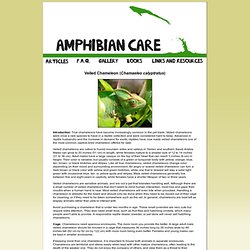

The Chameleon Enthusiast - Reptile-Sitting. Introduction and Acknowledgements My name is Noelle, A.K.A…The Chameleon Enthusiast!

I created this website, with the help of many people, in memory of my first veiled chameleon, Dietriche, who passed away in March 4th 2000. In doing so, my initial endeavor was to educate potential chameleon owners. It was not long until we expanded our efforts to encompass a rescue and rehabilitation service, as we were contacted when chameleons were dropped off at pet stores, no longer wanted and in poor health.
We then expanded into an international resource, when we started getting emails and calls from people around the world, asking for advice regarding their chameleons Over the years, the information provided on this site has changed, in response to new literature, new opinions, and experiences. It is my most sincere wish that all captive bred chameleons be cared for and respected by their owners, and the information required to care for their pet be provided. Thanks Guys! Chameleons For Sale: Panther Chameleon Breeders, Veiled Chameleon Breeders, Captive Bred Chameleons, Jacksons Chameleons for Sale, Chameleons for Sale at FL Chams.
Veiled Chameleon Care Sheet. If you like this website or webpage, please link it.

I could use the help. Thanks. Scientific classification: Chamaeleo calyptratus Getting Expert Advice Be aware that I am a pet owner, not an expert. Sexing First and foremost, I cannot stress this enough, if you have a female veiled, she is GOING to lay eggs or die, regardless of whether she's around a male or not. Male chameleons have a tarsal spur from the time that they are hatched: Females are missing this spur: Feeding What to feed Crickets primarily, supplemented with mealworms, superworms, waxworms, butterworms, etc. How often to feed Every day. Necessary Supplements. Veiled Chameleon Care. Veiled Chameleon Care Sheet. Gender & Sexing Determining gender in Veiled Chameleon's is very easy right from birth.

Males have a small, triangular lump on their back legs, right at the base of their foot. This is called a tarsal spur. You can also tell from their casque (the crest on their heads). This is a more difficult way of determining gender, and can only be seen later on in their development. Food & Water You want to offer your Veileds a wide range of foods, to provide a varied diet. Veiled Chameleons do not like standing water, and will very rarely drink this way, if at all. Lighting, Temperature & Humidity During the day it is important to offer lighting which creates a heat gradient of 80 degress F to 95 degrees F. Humidity should be kept to a minimum for Veiled Chameleons. Flourescent lighting should be offered to provide the Chameleon with needed UVB rays.
Housing. Veiled Chameleons. This article appeared in the July 1997 issue of Reptiles Magazine The veiled chameleon (Chamaeleo calyptratus) is the most commonly bred and available species of its genus in herpetoculture.

The popularity of the veiled chameleon is due to a number of factors: veiled chameleons are relatively hardy, large, beautiful, and prolific. It is not uncommon to encounter this species in pet shops, even pet shops that do not specialize in reptiles. Unfortunately, veiled chameleons are all too often purchased from reptile shows or pet shops without the correct information on their proper care and management in captivity. It is the responsibility of the seller to provide information on captive care, as it is also the responsibility of the purchaser to seek it before the animal is brought home. Amphibian Care >> Building a Screen Cage for Reptiles. Screen cages allow more ventilation than aquariums and traditional glass and wooden reptile cages.

They are often used to keep reptiles and amphibians that don't tolerate stagnant air. In December of 2002 I built a screen cage for a veiled chameleon. Below are photographs of the enclosure along with step by step instructions. The materials cost around $100 (US) and constructing the cage took only a few hours. To reduce costs more, consider building the window screens yourself rather than buying them already assembled. Tools Needed - Electric saw - Drill and drill bits - Screw driver - Mat knife or carpet cutter - Staple gun and staples - Ruler - Measuring tape - Pencil. Amphibian Care >> Veiled Chameleon (Chamaeleo calyptratus) Care. Veiled Chameleon (Chamaeleo calyptratus) Introduction: True chameleons have become increasingly common in the pet trade.

Veiled chameleons were once a rare species to have in a reptile collection and were considered hard to keep. Advances in reptile husbandry and the increase in demand for exotic reptiles have now made veiled chameleons one of the most common captive-bred chameleon offered for sale. Veiled chameleons are native to humid mountain sides and valleys in Yemen and southern Saudi Arabia. Males can grow to 20 inches (51 cm) in length, while females mature to a smaller size of 12 to 14 inches (31 to 36 cm). Veiled chameleons are sensitive animals, and are not a pet that tolerates handling well.
Avoid purchasing a chameleon that is under two months in age. Cage: Chameleons need spacious enclosures. If keeping more than one chameleon, it is important to house both animals in separate enclosures. Choose a cage that allows good air flow . Chameleons. Veiled Chameleon Care Sheet, Best Online Veiled Chameleon Care, Veiled Chameleon Information, Veiled Chameleon Cage, Veiled Chameleons for sale, Buy Veiled Chameleons.